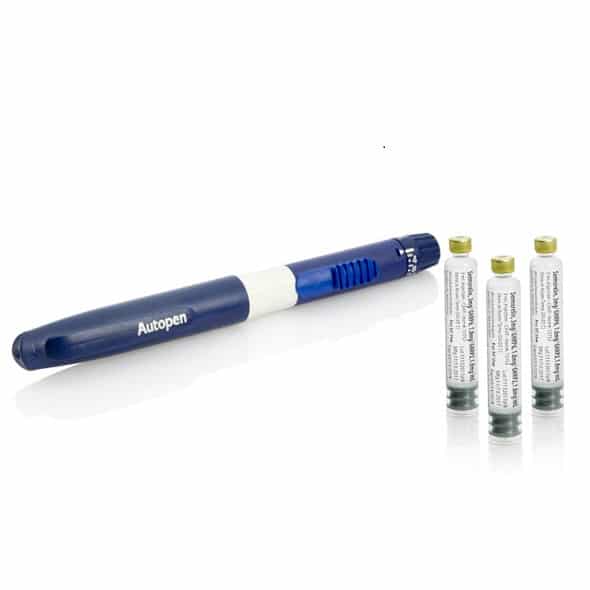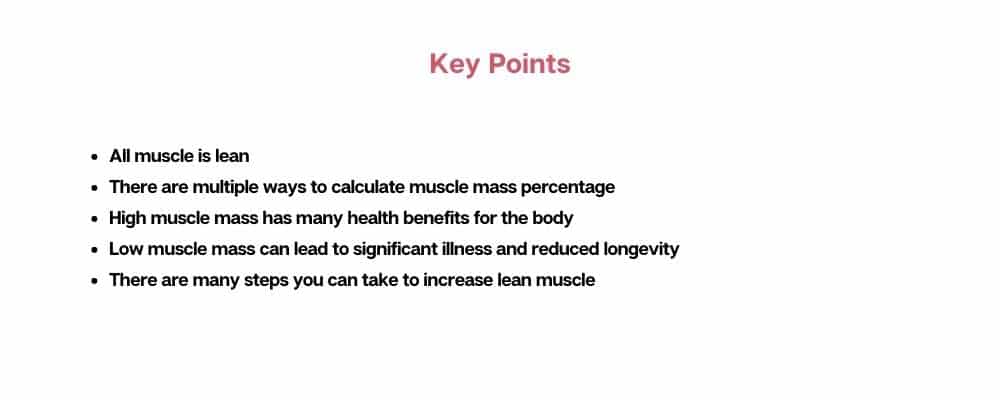
What is Lean Muscle Mass & How Can You Get a Lean Body?
Table of Contents
When talking about lean muscle mass, people usually refer to skeletal muscle. However, the body has three types of muscle that constitute muscle mass:
- Cardiac muscle – lining the walls of the heart
- Skeletal muscle – attached to the bones to facilitate movement
- Smooth muscle – lining organs and blood vessels to regulate specific functions
This article focuses on skeletal muscle and why it is important.
The Difference Between Lean Muscle and Lean Body
Lean muscle does not exist in the way people think. Muscle does not contain fat – all muscle is lean. The correct term is lean body mass or LBM. That means total weight minus fat mass.
The focus on lean body mass is on muscle and water, as bone density, while it decreases as you age, will not play a significant role in altering LBM. Healthy adult males have approximately 70 percent of their total body weight attributed to water. With their higher fat ratio, women have about 55 percent of their body weight in water. Because water weight differs significantly throughout the day, primarily due to water consumption, it can alter your lean mass. Muscle also contains as much as 79 percent water.
As you gain muscle mass, remember that one pound of lean body mass does not equal one pound of muscle, as water weight is involved.
How to Calculate Muscle Mass Percentage
There are multiple ways to calculate muscle mass percentage in the body, one of which is very expensive – magnetic resonance imaging (MRI) scan. We explain the most commonly used methods below:
The United States Army uses height and circumference measurements of the neck and abdomen in men and the neck, waist, and hips in women. Neck circumference is subtracted from abdomen circumference in men. Women add the waist and hip circumference before subtracting the neck for a final circumference value. These measurements are used with a chart showing height and circumference numbers to determine the body fat percentage.
- Body fat percentage
The traditional body mass index or BMI measures total body weight. It does not take lean muscle mass or body fat into consideration. A person can have a high BMI with low body fat if they are very muscular. Skinfold measurements use calipers to measure the thickness of pinched skinfolds. Men should check their abdomen, thigh, and chest. Women should measure their thigh, triceps, and above the hip bone. Online calculators can help estimate body fat percentage.
- MRI
An MRI can quantify muscle mass and quality and help diagnose sarcopenia when waist-to-hip-ration and BMI in obese patients may not provide that crucial information. Both MRI and computed tomography (CT) can assess the amount and quality of skeletal muscle with cross-sectional imaging.
- Body fat scales
Some scales today estimate the percentage of body fat using bioelectrical impedance analysis (BIA), which sends a weak electrical current that measures the body’s resistance to the signal. Because body fat is more resistant to the current, the higher the resistance, the greater the body fat. The scale will have you enter gender, height, and age information to assess your body fat percentage. Although not the most accurate assessment, these scales provide a useful estimate.
Once you have the body fat percentage, simply deduct that number from 100. The remainder is your lean body mass, which also includes your bones, organs, and other body components.
The chart below shows ideal body fat percentage for women:
| Category | 30 – 39 | 40 – 49 | 50 – 59 | 60 – 69 |
| Dangerously low | <14% | <14% | <14% | <14% |
| Excellent | 14 – 17.4% | 14 – 19.8% | 14 – 22.5% | 14 – 23.2% |
| Good | 17.5 – 20.8% | 19.9 – 23.8% | 22.6 – 27% | 23.3 – 27.9% |
| Fair | 20.9 – 24.6% | 23.9 – 27.6% | 27.1 – 30.4% | 28 – 31.3% |
| Poor | 24.7 – 29.1% | 27.7 – 31.9% | 30.5 – 34.5% | 31.4 – 35.4% |
| Dangerously high | >29.2% | >32% | >34.6% | >35.5% |
The chart below shows ideal body fat percentage for men:
| Category | 30 – 39 | 40 – 49 | 50 – 59 | 60 – 69 |
| Dangerously low | <8% | <8% | <8% | <8% |
| Excellent | 8 – 14.5% | 8 – 17.4% | 8 – 19.1% | 8 – 19.7% |
| Good | 14.6 – 18.2% | 17.5 – 20.6% | 19.2 – 22.1% | 19.8 – 22.6% |
| Fair | 18.3 – 21.3% | 20.7 – 23.4% | 22.2 – 24.6% | 22.7 – 25.2% |
| Poor | 21.4 – 24.9% | 23.5 – 26.6% | 24.7 – 27.8% | 25.3 – 28.4% |
| Dangerously high | >25% | >26.7% | >27.9% | >28.5% |
Depending on age, men between 36 and 75 should have between 32 and 40 percent muscle mass. Women in the same age groups should have 27 to 31 percent muscle mass.
What is Good and Bad About Having High Muscle Mass?
Muscle is crucial for optimum health. The larger the muscles, the more energy (calories) the body will burn. Additionally, maintaining healthy muscle mass may increase longevity, as found in a study published in the American Journal of Medicine. Adults with high muscle mass often have lower fat mass, reducing the risk of high cholesterol, glucose dysregulation, atherosclerosis, decreased cardiac output, and other cardiovascular risk factors.
Benefits
- Cushioning the bones and protecting the skeletal system from damage
- Some muscle-building exercises can also increase bone density
- Supporting free movement and mobility
- Boosting metabolism and aiding in weight loss
- Pulling more glucose from the bloodstream to store in the muscles for energy
- Improving mental health (stretching and exercise increase serotonin levels)
Side effects
- Gaining too much muscle in a short time can place a strain on other areas of the body
- Increased caloric intake is required to maintain muscle size and help the body feel satisfied (can increase grocery costs)
- Some people experience decreased flexibility and mobility with larger muscles
- Finding clothing may be difficult if the muscle size is too large, as clothes may not fit properly
What is Good and Bad About Having Low Muscle Mass?
Low muscle mass typically means having a higher body fat mass. Increased fat crowds the internal organs, putting a strain on their functions. Reduced lean muscle increases the risk of many health problems. It can also lead to more severe fractures. As many as one in three adults over 50 may die within 12 months of suffering a hip fracture.
Benefits
There are no benefits to having low muscle mass unless you view having more options for clothing choices as a benefit.
Side effects
- Increased risk of diabetes, osteoporosis, and injury to bones
- Weakness
- Early death – often associated with illness or injury
- Reduced quality of life
- Increased chronic inflammation
- Potential increase in surgical complications/longer hospital stays
How to Gain Lean Muscle Mass
Most people immediately think of strength training as a way to build muscle. Tiny tears occur in the muscle fibers as you use this resistance training. The process of repairing those fibers increases the size and strength of the muscles.
Below we look at the many ways you can help your body gain lean muscle mass:
Exercise
The proper exercises, especially resistance training, help build muscle. The primary thing to remember is not to overdo it. High repetitions with short rest periods of 30 to 40 seconds bring superior results. Pilates stretches the muscles and can also help improve lean muscle mass. Cardio or aerobic exercise improves overall fitness and helps support muscle function and growth. Make sure to leave time for rest and recovery – as that is when your muscles have the chance to repair themselves and grow.
Improve your diet
The body needs high-quality food to support muscle growth, especially protein. Eggs, oily fish, chicken, nuts, beans, seeds, and beef are excellent protein sources. A variety of colorful vegetables and fruits provide crucial nutrients the body requires. Carbohydrates are crucial for strength training. Avoid processed and fatty foods, as well as those high in sugar.
Get enough sleep
While you sleep, your body sends testosterone and human growth hormone (HGH) into the bloodstream to aid tissue repair, including damaged muscle fibers. When you exercise during the day, your body repairs those muscles at night. If you do not get enough sleep, cortisol levels increase, and testosterone and HGH production decrease. The body cannot recover, and muscle repair cannot occur.
Decrease stress
When you are stressed, your body increases cortisol production. Ongoing stress keeps cortisol levels high, inhibiting the production of testosterone and human growth hormone, which are crucial for muscle maintenance and growth. Cortisol pulls energy (protein) from the muscles, causing muscle atrophy as it converts it into glucose. At the same time, cortisol tells the body to store fat in the hips, belly, and thighs.
Get HRT prescribed
Hormone replacement therapy (HRT) can help improve lean muscle mass for those suffering from hormone deficiency or imbalance. Testosterone replacement therapy (TRT) and HGH therapy provide the following benefits for those who need them:
- Reducing protein breakdown in the muscle
- Improving protein processing
- HGH, along with insulin growth factor 1 (IGF-1), stimulates cell regeneration
- Stimulating anabolic hormones to promote protein synthesis and muscle growth
- Activating satellite stem cells to aid in muscle development
Taking the right actions can help improve lean muscle mass, strengthen the body, and support crucial functions associated with lean muscle.

Conclusion
Maintaining adequate lean muscle mass is crucial as you age. Exercise (cardio and resistance), rest, recovery, nutrition, sleep, and stress reduction all play a role in helping increase lean muscle.
For those who need it, hormone replacement therapy can make quite a difference – not only in muscle mass but also in bone density, health, and overall well-being.
FAQ
Does lean muscle mean skinny?
Lean muscle does not mean skinny. It indicates a body without a high body fat mass. Also, all muscle is lean as muscle does not contain fat.
What workouts help lean muscle?
Resistance (strength) training, cardio (aerobic), and Pilates can all help build lean muscle. High repetitions with short rests are beneficial.
What are 5 foods to increase lean muscle?
Lean protein is the best option for increasing muscle, including beef, oily fish, chicken, beans, and nuts. Carbohydrates, fruits, and vegetables are also crucial.
How long does it take to build lean muscle?
Building muscle takes time, as most people gain only a pound or two of lean muscle per month. Noticeable changes may take a couple of months.
How do I know if I'm gaining muscle or fat?
Muscle mass is typically well-defined and feels harder to the touch. Fat mass is softer and will often cause clothes to feel tighter.


